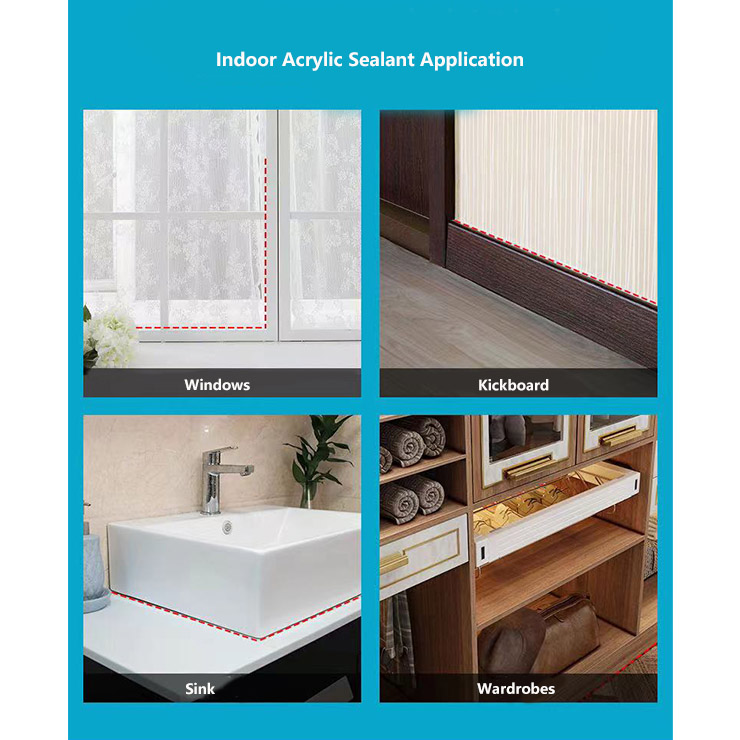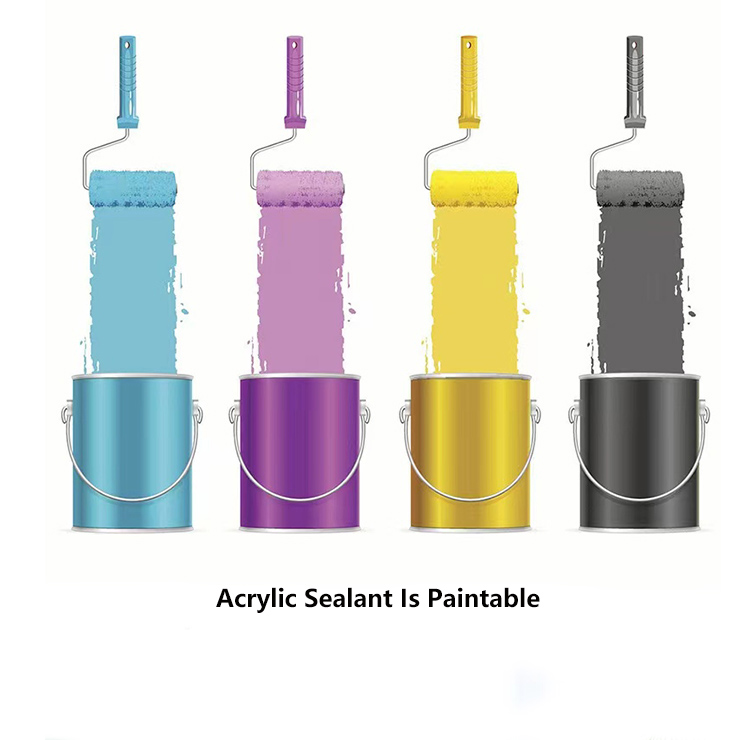Today we are going to talk about acrylic sealant, through this article you will know what is acrylic sealant, where is it apply and how to choose?
Here are the outline:
- What is acrylic sealant?
- What properties acrylic sealant has?
- Where does acrylic sealant adhesive apply?
- What’s the difference between acrylic sealant and silicone sealant?
- How to choose? silicone sealant or acrylic sealant?
What is acrylic sealant?
Water based acrylic sealant is made by emulsifying acrylic or polyurethane resin through special emulsifying equipment with water as solvent.
Acrylic sealant is also called painters caulk, acrylic adhesive, acrylic caulk, water based concrete sealer, water based sealant, acrylic gap filler, paintable acrylic caulk, waterproof acrylic sealant, acrylic sealant interior and decorators caulk etc.
What properties acrylic sealant has?
- Good fluidity in a wide temperature range, strong adhesion, good elasticity and good weather resistance once cured
Because acrylic sealant contains methacrylic monomer, acrylate copolymer, benzoin propyl ether, α-methylstyrene oligomer and activator, etc.
- Non-toxic, harmless, non-flammable and volatile
- Variety, environmental friendly, low VOC
The water-based environmentally friendly formula system of acrylic water-based sealant ensures ultra-low VOC emissions which can be used in a large number of indoor environments that require caulking and sealing but also require low VOC emissions
- Fast cure and cheap price
- Good air permeability
Using acrylic emulsion as the base material of the colloid, the colloid has dense capillary pores, so that the colloid has good air permeability and ensures the dryness and cleanness of the seal
- Paintable
- Good adhesion and waterproof
- Poor acid and alkali resistance
- Easy to use and clean
Where does acrylic sealant adhesive apply?
Water based concrete sealer is one of the varieties of acrylic sealant, which can be widely used in Interior decoration, general construction expansion joints and general engineering joint filling in non-long-term water-immersion environment waterproof sealing.
For example, it is used to seal the gaps between indoor walls, skirting lines, door and window frames and the walls etc. It has good adhesion to building materials such as aluminum, glass, and ceramic tiles.

In 2009, Guangzhou Jointas Chemical successfully launched the acrylic indoor water-based sealant, antas-153 acrylic gap sealant and antas-622 ms gap filler which was the first to sing the theme song of environmental protection in China's sealant industry and was at the forefront of the industry.
Acrylic indoor water-based sealant is a truly new generation of environmentally friendly products.
Antas-153 and antas-622 single-component indoor water based caulk is safe and environmentally friendly. There is no organic solvent volatilization during use.
What’s the difference between acrylic sealant and silicone sealant?
- In terms of composition, acrylic sealant contains acrylic acid, acrylate and its polymers; the main component of silicone sealant is silicone polymer.
- Acrylic sealant is paintable while silicone sealant can not be painted
- Acrylic silicone sealer is more environmentally friendly and cheaper price than silicone sealant
- Water based sealant is used for sealing various flat surfaces like between plastic steel windows and walls to achieve waterproof and beautiful effects. Silicone caulk can be widely used in installation, bonding, glass sealing and other occasions.
- Siliconized acrylic caulk weather resistance is not as good as silicone sealant, it will fall off after wind and sun year by year which is widely used in interior house. While silicone sealant has excellent heat resistance, cold resistance and good weather resistance properties that can be use in outdoor and indoor. It has good adhesion to various materials, has good tensile-compression fatigue resistance.

How to choose? silicone sealant or acrylic sealant?
Silicone is one of the most used raw materials in the industrial field, almost all walks of life need to use silicone sealant. There are many types of sealants on the market including acetic sealant, neutral sealant, insulating glass sealant, aquarium silicone, anti mould silicone and weatherproof silicone sealant etc.
Silicone sealant can be divided into acetic cure silicone and neutral sealant, a previous article also mentioned the difference between acetic silicone and neutral cure sealant. If you are interested, you can read this article.
So how can we choose the most suitable sealants in the face of so many types to achieve product bonding, leak repair, sealing or other purposes?
- Relative to other sealing systems. Silicone sealant is the first choice. The quality of silicone sealant is stable and the effect is lasting. It is not as high as the shrinkage rate of the acrylic sealant. Therefore, they are extremely cost-effective, especially when used in kitchens and bathrooms, and they are well-deserved first-choice products.
- How compatible is the silicone sealant with the paint or coated surface? Most silicone sealants cannot be painted. If you want to color, please choose hybrid sealant or acrylic caulk.
| Main types |
Advantages |
Disadvantages |
Main Usages |
| Silicone |
Excellent weatherability |
Bad adhesion to porous materials
Poor paintability |
Bonding and sealing for windows,door and curain wall |
| Acrylic |
Environmental friendly |
Poor weatherability, High shrinkage |
Interior gap filling and sealing |
Jointas is a top 3 brand acrylic sealant manufacturer in China, we offer free sample for new customers to test the quality if you are interested in please feel free to send inquiry, thanks!
Related Article:

